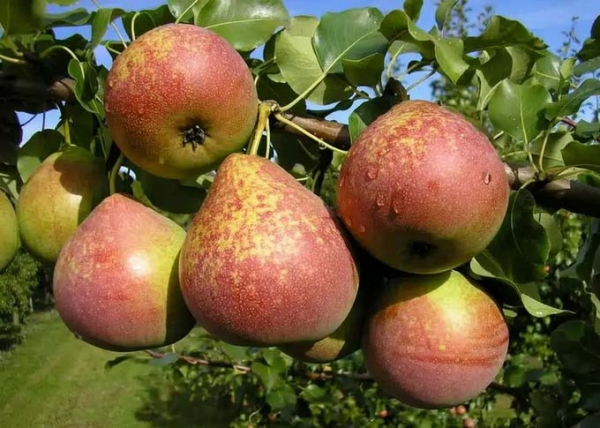Many gardeners dream of growing reference fruit crops on their land. To one of them can be attributed pear varieties Marble, which is distinguished by its great taste.
Table of contents
Description varieties of pear Marble
Marble variety was bred in the Voronezh region in 1965. Its authors were G. D. Neporozhny and A. M. Ulyanischeva. Parent varieties are Bere winter Michurina and Forest Beauty.
According to the description, the tree itself is notable for its small size and grows to a height of no more than 4 meters. The crown of average density, in form resembles a wide pyramid. The branches are located at an angle close to a straight line. The bark on the trunk and the main branches of gray-green color.
Shoots in this variety are red-brown and slightly upwards. The leaves are bright green, smooth, have an ovoid shape and sharpen closer to the shoots, at the edges there are small notches. The size of both leaves and petioles is average.
The flowers of this tree terry, with a diameter of not more than 3 centimeterscollected in inflorescences of 8 pieces. The petals are slightly closed, while the edges are solid. Pestles are on par with anthers.
Up to 200 kilograms of crop is harvested from one tree.
It is best to grow Marmara in a warm climate.. The official distribution areas are considered to be the Central region, the Voronezh and Bryansk regions.
Given the poor frost resistanceThis variety cannot be grown in areas with a cold and changeable climate.
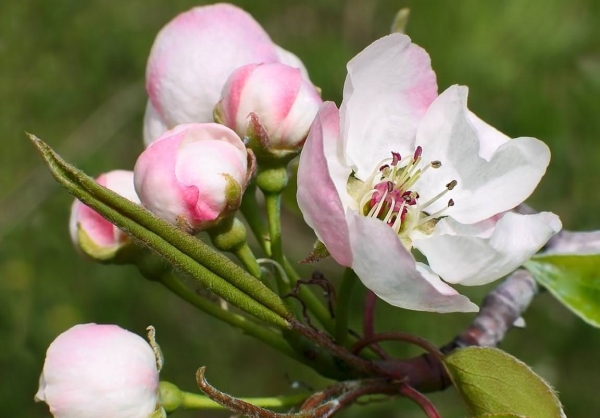
Fruit characteristics
The fruits of this variety contain a huge amount of nutrients, besides have excellent taste. The tasting score of these pears is 4.8 points out of 5.
Their flesh is distinguished by a delicate cream shade, juicy and sweet taste, a pleasant aroma and a coarse-grained structure.
In most cases, one fruit weighs 130-170 grams, but there may be specimens weighing up to 220 grams. Pear color golden green, covered with red, marble blush, the form is correct, pear-shaped.
The saucer is small, seed chambers are medium in size, light brown in color. A cup on the type of half-tucked.
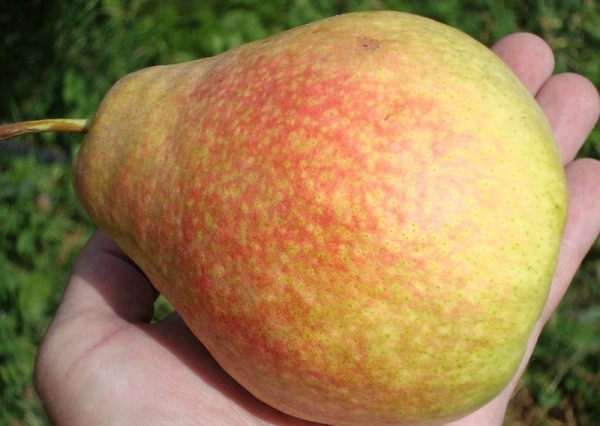
Advantages and disadvantages
Advantages of the variety:
- The main advantage of Marble is resistance to powdery mildew, scab, and fruit rot;
- pear skin is thick and durable, so that the fruit is well tolerated transportation;
- Many sweets adore this variety, because it has a sweet and juicy taste, bright aroma;
- up to 200 kilograms of harvest can be harvested from a single tree, which makes Marmara attractive enough for commercial purposes.
The disadvantages are as follows:
- the grade does not tolerate the winter season;
- does not tolerate dry weather, because of which, with insufficient watering, the fruit may begin to crumble;
- after planting Marble grower will have to wait a long time for the first harvest, fruiting comes in 6-7 years of life;
- if May was particularly cold, then you can lose not only flowers, but the whole tree as a whole.
Features of planting and care
The first step will be the selection of seedlings. In order for the purchase to be successful, and the tree quickly settled down on the site, when buying planting material are guided by the following indicators:
- the age of seedlings should not exceed two years;
- root system should consist of 3-5 shoots, 25-30 centimeters long;
- if a one-year-old sapling is purchased, it may consist of one stem, while a two-year-old specimen must have at least 3 side branches;
- on the roots and bark should not be mechanical damage, cracks and the consequences of past diseases.
It is best to choose seedlings with a closed root system., because the earth com is a natural defense against damage.
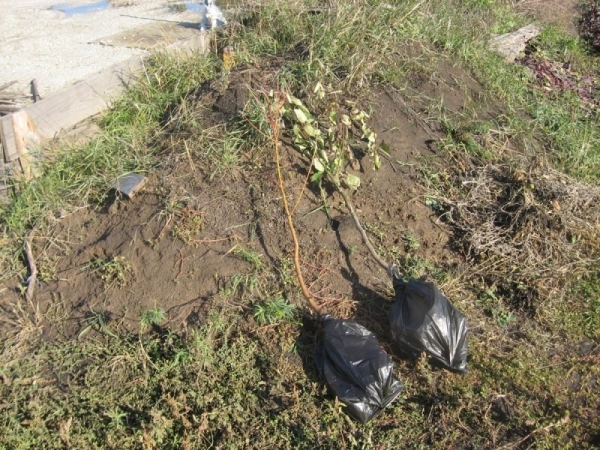
Then you need to decide on the landing site, taking into account the individual characteristics of the Marble:
- tree pollinators are required, in the form of which other varieties of pears appear, the flowering period of which coincides with Marble. The best options are Severyanka, Cathedral, Lada, Chizhovskaya and Tatiana;
- plot for planting pears should be as lit as possible;
- the tree does not tolerate strong winds, so this variety is better protected from such a manifestation of nature. As a shelter, a low structure or fence is well suited;
- high groundwater deposition can erode the root system or cause mold;
- marble does not tolerate stagnant water, so you need to take care of its removal in advance.
The soil should be loamy, loose and nutritious. If the soil is sandy or clay, then you need to add fertilizers such as humus,manure or peat.
1-2 weeks before the immediate planting of the pear soil need to prepare:
- The diameter of the pit should be 60 cm, and the depth is 80 cm. When digging a hole, the soil is removed in layers, because the upper part is fertile and the lower part is not.
- Then the upper part of the soil is mixed with the following fertilizers: 7-10 kilograms of humus, 40 grams of potassium, 200 grams of superphosphate, 150 grams of wood ash.
- If the soil does not meet the requirements, then 300 grams of limestone is added for drainage.
- At the bottom of the pit lay out the shells of walnuts or tin cans, then add the mixture, taking into account the fact that one third will remain free.
- A support is installed in the middle of the pit, its length should not be less than 130 centimeters.
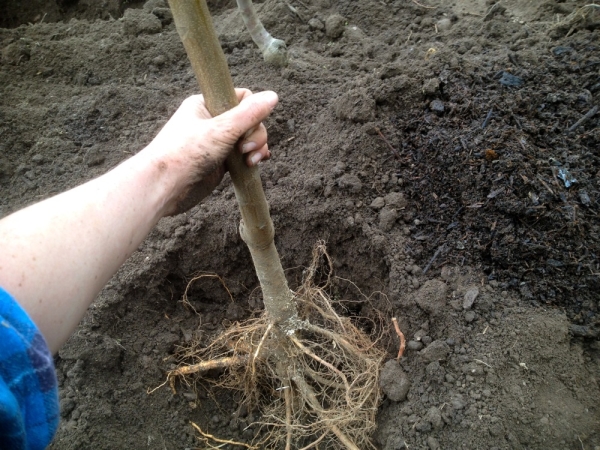
If the roots of the seedling dried outthen they are immersed in a clay talker. Damaged areas are cut off with a sharp sheath, and 80 percent of the leaves are also removed.
When choosing a planting scheme, it is worth remembering that the vigorous trees should be at a distance of 6-7 meters, and the average height of 4 meters.
Planting a pear need to pay attention to the root penetrationit should be 3-5 centimeters above ground level.
After the seedling is placed in the soil, it must be carefully tamped down and build a hole for watering the plant.
Immediately after planting, the tree is abundantly watered and mulched with hay, sawdust or grass. Between plantings Marble can grow vegetables or berry crops.
Planting this variety can be done both in spring and in autumn.
In autumn, the beginning of October will be the preferred time.so that the tree could get stronger before the onset of cold weather.
Growing conditions
Marble is extremely unstable to drought.therefore, it is necessary to water it very carefully. The lack of the required amount of moisture can reduce the amount of the crop several times.
On average, 3 buckets of water are consumed per tree, up to 5 buckets must be added in dry weather. It is better to water the tree using special holes or grooves.
This variety requires a fairly large number of feedings.
During the flowering period you need to make nitrogen-containing substances, such as 100 grams of urea, diluted in 5 liters of water.
In June, to maintain the formation of fruits use 50 grams of urea per 5 liters of water. In July, potassium sulfate 100 grams per 5 liters of water.
To maintain future fruiting, after harvest the root zone is dug up and introduced 1 kilogram of bird droppings, 5 kilograms of compost or 2 kilograms of manure.
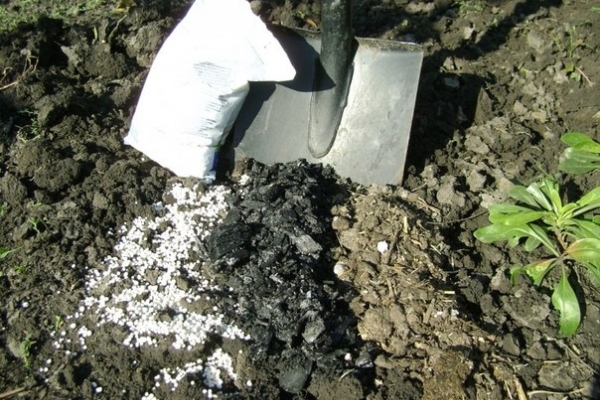
For the same purpose, phosphorus and potassium are used. The size of the introduced substances will depend on the age of the tree:
- up to 12 years - 4 grams of phosphorus and 6 grams of potassium;
- from 12 to 20 years - 6 grams of phosphorus and 8 grams of potassium;
- over 20 years - 6 grams of phosphorus and 12 grams of potassium.
To stimulate fruit set and highest yields, 10 days after flowering the tree is sprayed with 1% urea solution, the procedure will need to be repeated in 1-2 weeks.
For trees whose age does not exceed 5 years, all top dressings are made 1-2 meters in diameter from a pole; for adult plantings, this indicator increases to 3-5 meters.
It is best to prune the tree in springbefore the movement of the juice or in the autumn after harvesting, at a temperature not lower than 8 degrees. The first two years of life are removed only dry or damaged branches.
Then need to carry out sanitary pruning of treesby removing diseased or damaged branches.
The pear should be cut using a sharp pruner. After drying, the wounds of the injury site are treated with garden pitch.
Whitewashing a tree trunk will protect it from frost., sunlight and rodents. This procedure should be carried out in the fall and spring, using the following mixture:
- 10 liters of water;
- 1.5 kilograms of clay;
- 2 kilograms of lime.
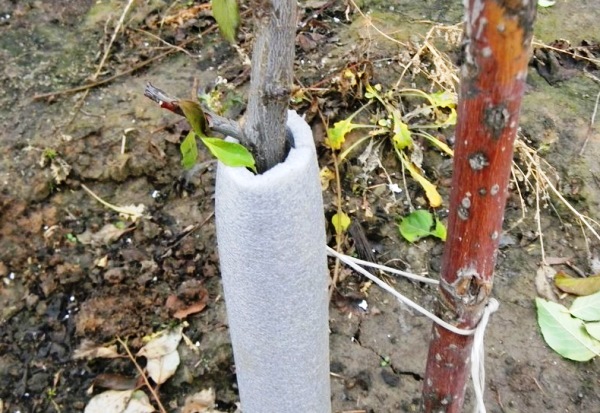
Considering that Marble does not tolerate cold, the tree is carefully prepared for winter:
- it is necessary to remove all the fallen leaves and remove the last hanging fruit;
- plentifully water the tree using 50-100 liters of water, then it must be mulched using hay or sawdust;
- a tree trunk and large branches are covered with cotton, breathable material.
This grade is necessary protect not only from the winter cold, but also from the spring frosts.
Harvesting and Storage
Marble is fully ripened in October, but you can start collecting fruits in September. It is best to shoot pears in the morning, tearing along with the stalk.
Fruit should be stored in a dry room with a temperature of 0-1 degrees. The tank must be dry crates or wicker baskets are best suited.
Under all conditions, pears can lie for up to 2 months.
Features grade
Thanks to these qualities Marble pears are recommended by many nutritionists. These fruits do not increase appetite and contain a small amount of calories.
This grade is an excellent pollinator for many other pears, but at the same time, the process of self-pollination occurs with difficulty.
Marmara love breeders. With its help, you can get quality varieties of pears, it is an excellent donor.
The negative qualities of mono include poor resistance to coldBecause of this, the tree has to be sheltered not only for the winter, but also in May, during the spring frosts.

Diseases and pests
Marble is resistant to such diseases as powdery mildew, scab or fruit rot, but there are diseases that can affect the tree, so it is very important to know the preventive measures and how to treat it.
Pear mite - sucks the inside of the leaves in early spring, before the buds swell, the tree should be sprayed with a solution of colloidal sulfur.
Black cancer - is one of the most dangerous diseases, when a darkening appears on the cortex, the damaged area is cut off, capturing 2-3 centimeters of the healthy part. Then the cut is processed with a 2% solution of iron sulphate.
Medianitsa - As a preventive measure during flowering, the tree is sprayed with an infusion of yarrow or chamomile.
Leaf Rust - orange spots begin to appear on the leaves, after flowering, they are treated with 1% Brod's liquid, and after the leaves fall, the branches are treated with 5% urea solution.
Moths - to get rid of insects, it is necessary to collect all the scattered carrion and sprinkle the leaves with water during the summer of butterflies.
Green aphid - Get rid of pests will help processing wood soap solution with anabasin.
Sunburn - Regular whitewashing of a tree column helps best.
Cytosporosis - the bark of the tree becomes dark red and dries out gradually, mostly old or weakened individuals suffer.
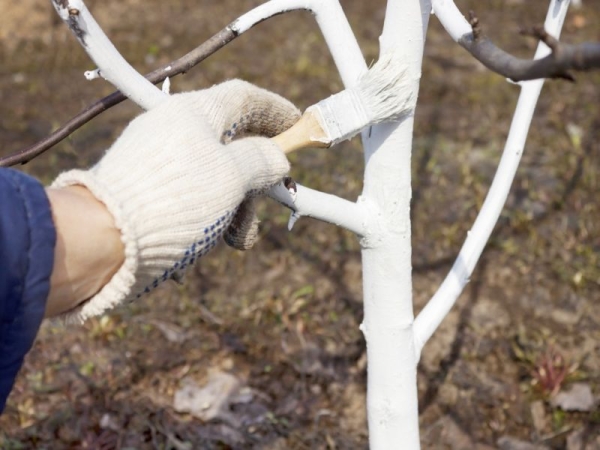
To prevent the occurrence of the disease, need to whiten the trunks and avoid damage. Infected areas are removed and treated with copper sulfate solution.
The most important method for prevention and the treatment of diseases is the timely removal of infected or suspicious branches, after which they must be burned.
Gardeners reviews
Olga: “I planted a Marmara pear in my plot and did not regret it at all, our climate is warm enough, we live in Orel. Yes, a tree can be, it freezes, but the taste of the fruit itself always stays at the highest level. If you take care of the tree correctly, it will bring a huge amount of harvest, from which I can make jam and compotes. ”
Vasiliy: “The next year I am going to remove Marble from my plot, the tree is constantly freezing, it requires a huge care. In addition, there is no acidity in taste, and without it, in my opinion, the pear is no longer a pear. In addition, this variety can sharply stop the ripening of fruits, and they remain hanging until late autumn, while other trees regularly produce crops. ”
Irina: “I adore Marmara for its wonderful taste, besides, the appearance completely allows using this variety for sale. If you collect pears in the fall, then they resemble melon in taste, a very unusual combination of flavors is obtained. ”
But if the weather allows you to grow this variety, then such fruits will decorate any table. Gentle, sweet, juicy, with flesh melting in the mouth, they will become the favorites of both children and adults.
